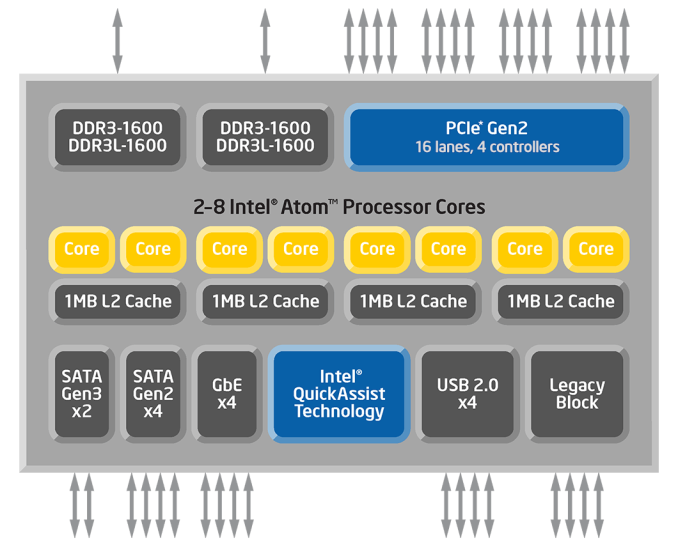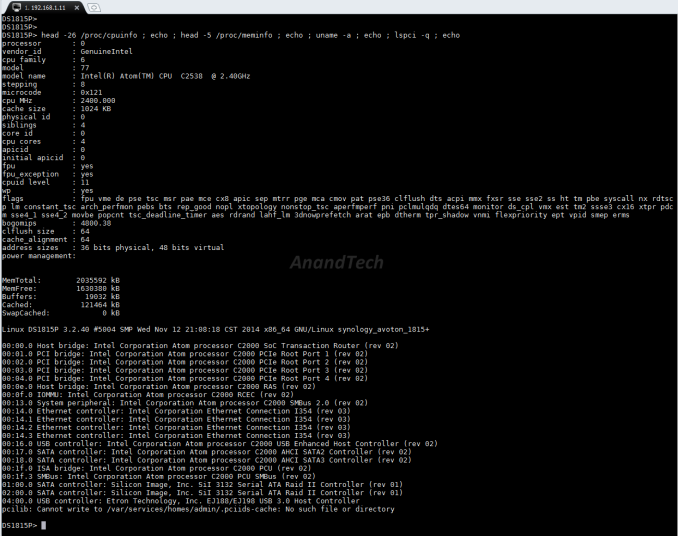Synology DS1815+ 8-bay Intel Rangeley SMB NAS Review
by Ganesh T S on November 18, 2014 6:30 AM ESTPlatform Analysis
The higher end segment of the SOHO / SMB NAS market uses Intel's Core-series and Xeon CPUs to deliver the required performance while supporting a large number of drive bays (typically more than 8, in a rackmount form-factor). Over the last four years or so, Intel's play in the other tiers has been mainly with its Atom CPU lineup. Back in 2010, Intel pushed the 45 nm Atom D410 / D510 / D525 for NAS units. In 2012, it was the 32 nm Atoms, the D2550 and D2700. All of these were based on the in-order Bonnell microarchitecture which was fast becoming dated compared to the advancements being made by the ARM SoC vendors. In moving from 32nm to 22nm, Intel completely revamped the microarchitecture for their Atom cores. Bonnell was replaced by Silvermont, bringing out of order execution and other improvements into the picture. Silvermont's applicability to a variety of power profiles meant that there were multiple product lines that ended up using the CPU cores. Bay Trail is proving very effective in tablets and also makes up QNAP's TS-x51 and TS-x53 Pro NAS series. Merrifield and Moorefield are trying to break into smartphones, but it is Avoton and Rangeley that are more relevant to the storage appliances market.
The different product lines integrate different I/O around the Silvermont cores depending on the target market. Avoton is meant for microservers and cloud storage platforms, while Rangeley is meant for communication and network infrastructure. Both of them integrate similar I/O around the cores, but the Rangeley parts have an updated crypto engine. The block diagram of a generic Rangeley part is provided below.
There is a wealth of I/O (2x SATA Gen 3, 4x SATA Gen 2 and up to 16 PCIe 2.0 lanes) for the storage subsystem, and the parts also support up to 4x 2.5 Gbps network links. From the viewpoint of the Synology DS1815+, the above block diagram should be considered in the context of the information gleaned via SSH access to the unit.
The DS1815+ uses the Intel Atom C2538 SoC which has four Silvermont cores running at 2.4 GHz. It is backed up by 2 GB of DRAM. The Atom C2538 has 16 PCIe 2.0 lanes. The Silicon Image SiI3132 PCIe to 2-port SATA II host controller uses a single PCIe 2.0 lane on the host side. There are two of them using up two PCIe 2.0 lanes in total. Unlike the DS415+ in which the USB 3.0 ports were provided by the Etron EJ168 USB 3.0 host controller, the DS1815+ uses the Etron EJ198. This USB 3.0 host controller uses two PCIe lanes to enable the four USB 3.0 ports found on the rear side of the unit. The four Ethernet controllers are all based on the Intel I354. Despite being 2.5G-capable, the transceivers they are connected to make them GbE ports.
The more interesting hardware aspect is the absence of any PCIe to SATA bridges for the internal ports. Given that the C2538 has only a total of six SATA ports (2x SATA III and 4x SATA II) and there are no bridges in the SSH report, it can be inferred that a port multipler (1x SATA host to 2x SATA device) such as the ASMedia ASM1092 must be in use. However, without opening up the unit (which we haven't done yet, given our limited time to bring out the review), this can't be confirmed.
On the software front, the DS1815+ runs Linux (kernel version 3.2.40). We have covered DSM 5.0's setup and usage impressions in our recent DS214play and DS414j reviews. There is not much point in rehashing the same excellent setup and usage experience. That said, with the ioSafe 1513+, we also started looking at iSCSI support in NAS units. We will be looking at that aspect in this review also.












65 Comments
View All Comments
JeffFlanagan - Tuesday, November 18, 2014 - link
I was looking into an NAS for media storage on my home network and concluded that I was much better off hooking up a bunch of 4TB USB drives to a low-power PC, because the PC can also do things an NAS can't, like running Plex Server well. With USB 3.0 it's just as fast as internal storage.SlackMasterDoug - Tuesday, November 18, 2014 - link
Just FYI you can run plex on any x86 based Synology. I have it on my DS1512+ and it works just fine.This isn't supposed to be the cheapest option. As other comments have pointed out, this is for the person that just wants it to work with minimal care and feeding. I've set up plenty of freeNAS solutions that would be cheaper to build than what I have with my Synology. However, the ability to do basically nothing but updates for the past 2.5 years and have it all work is worth it. Plus its all self contained, uses little energy and is quiet.
SirGCal - Tuesday, November 18, 2014 - link
Ya, I'm all for doing it yourself anyhow but these Syn boxes can Plex without an issue. They cannot however do some of the other things I use them for but that's another topic a bit outside the scope of all this. Still your own rig can potentially do more and be more useful and obviously cheaper so if it works for you, that's the whole point. Sweet.peterfares - Tuesday, November 18, 2014 - link
You and most people other than those who have a weird obsession with Synology.RandomThis - Friday, November 21, 2014 - link
I always wonder if these "not worth the money, I can build one for 1/x the price" are troll posts, or if people are seriously comparing items the consumer can expect to just buy, plug in and use, versus something they have to research, build and maintain. When I buy synology units I don't pay $1000+ for the hardware, I pay for people to research and develop a solution that works out of the box in a form factor that I find appealing, that takes 10 seconds of my time to maintain. If I didn't work, didn't have kids, and had nothing better to do, I would keep building custom FreeNAS units. As things stand, I buy synology units instead.As for the "I can set up a custom solution in 30 minutes", No. Factor in the time you spend researching the hardware, OS, software, just to mention a few. And the first time you run into a problem in FreeNAS, prepare to put aside a few hours. Admittedly, I had a lot of fun when I put together my FreeNAS unit, however now my time is much too precious to waste on something as minor as NAS units. When I had free time to spare, I was not Synology's target market. Now I am.
Mech049 - Friday, November 21, 2014 - link
I always wonder if these "not worth the money, I can build one for 1/x the price" are troll posts, or if people are seriously comparing items the consumer can expect to just buy, plug in and use, versus something they have to research, build and maintain. When I buy synology units I don't pay $1000+ for the hardware, I pay for people to research and develop a solution that works out of the box in a form factor that I find appealing, that takes 10 seconds of my time to maintain. If I didn't work, didn't have kids, and had nothing better to do, I would keep building custom FreeNAS units. As things stand, I buy synology units instead.As for the "I can set up a custom solution in 30 minutes", No. Factor in the time you spend researching the hardware, OS, software, just to mention a few. And the first time you run into a problem in FreeNAS, prepare to put aside a few hours. Admittedly, I had a lot of fun when I put together my FreeNAS unit, however now my time is much too precious to waste on something as minor as NAS units. When I had free time to spare, I was not Synology's target market. Now I am.
And to answer those "oh, your time is worth $800 for the time it takes to put together a NAS", Yes. That's the amount of money I would need to be paid to do something I do not have an interest in doing. Add the fact I wouldn't be spending time with my kids, and $800 is a very good deal.
Mech049 - Friday, November 21, 2014 - link
Apologies for the double post. Wouldn't stop loading when I tried to post on my iPad so I tried to post using my PC. Of course it posted on both devices... Mods please combine, or delete the first post if possible.edward1987 - Monday, February 1, 2016 - link
It is better to have a tool dedicated for purpose. Computer is like: what fits everything fits nothing. You get support , upgrades and cool functionality from Synology. Plus if you talk directly to SPAN dot COM you can get better deal than elsewhere!DanNeely - Tuesday, November 18, 2014 - link
For the encryption performance graph, putting the non-encrypted performance numbers would be helpful. Not a huge deal with this one since there was minimal impact; but being able to see how large the penalty is without having to switch back and forth would be helpful on reviews of less capable models.And like I've commented previously; with current generation NASes growing from just boxes of disk drives into light weight general purpose servers as well, your tests really need to be expanded to capture at least some of that capability. I'd suggest running a web server and measuring how much light traffic on that impacts the rest of the devices performance and virtualization hosting abilities for models that offer it (still just QNAP?) at a minimum.
vLsL2VnDmWjoTByaVLxb - Tuesday, November 18, 2014 - link
USB3 has CPU overhead far greater than any built-in storage overhead, isn't RAID aware, suffers from serious latency issues in comparison to SATA, and eats up a port that could be used for peripheral use. USB3 should be used for removable access primarily, and nearline storage secondarily.Not saying you are doing it wrong, but USB3 doesn't scale after the second disk is added. That's a serious problem.